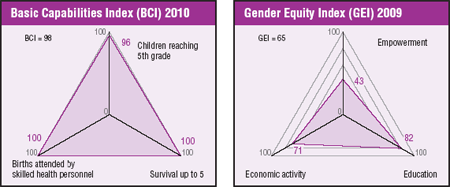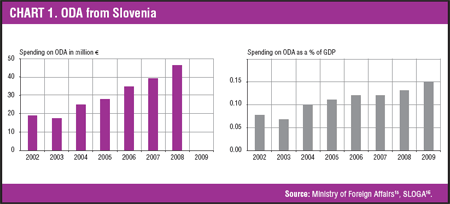The MDGs: a very distant target
Društvo Humanitas
Rene Suša
The global crisis has demonstrated that if Slovenia is to survive in the new international environment it has to experience social, political and economic paradigm shifts. Regarding development assistance, the country has neither a strategy for development cooperation nor a system to evaluate aid efficiency. Its commitments will be difficult to uphold in the current context where there are national budget cuts in almost every sector. At the same time, and despite the documented success of their grassroots projects, civil society organizations are still considered minor players in the development arena.
 |
The election of former UN Assistant Secretary-General for Political Affairs, Dr. Danilo Türk as president, in the 2007 elections seemed to signal that Slovenia was beginning to realize the importance of the international dimension, particularly international cooperation, in reaching some of today’s most challenging goals. Three years later, however, that hope is all but spent. Global issues rank extremely low on the political agenda, internationally accepted obligations are not being met and the public’s lack of awareness on these issues, including the Millennium Development Goals (MDGs), is alarming – especially among the young.
The “crisis” period has demonstrated that the country has to experience some radical social, political and economic paradigm shifts if it is to survive in the changed global environment. A team of experts from various disciplines (the economy, philosophy, environment protection, etc.) together with the former ombudsman and a member of the Cabinet prepared a document with a challenging title – Where after the crisis?[1] – that called for just such a change. While the paper gained widespread media interest and won the approval of both the Prime Minister and a considerable proportion of the general public, it was almost completely ignored when a new development strategy for 2010–2013 was prepared.
Words and actions from the same source rarely operate in tandem in Slovenia’s political sphere, which is precisely what makes the realization of the MDGs such a distant possibility. It seems that the country simply does not understand that it is in fact part of a larger and more interconnected world.
Lacking strategies for development cooperation
In 2004 Slovenia assumed the obligations of providing international aid. Being promoted to donor status by the World Bank and joining the EU has had a lasting impact on the Slovene foreign assistance policy. While the numbers are still not overly encouraging – the country spent 0.15% of the gross domestic product (GDP) in 2009 for official development assistance (ODA)[2] – a positive trend in the past few years is clearly discernible (Chart 1).
 |
Compared to 2003, the amount of ODA more than doubled in 2008. It should be noted that a sizeable amount of ODA is comprised of payments to the EU budget – EUR 18.57 million (USD 22.2 million) in 2007.[5]
Slovenia is supposed to reach the target goal of 0.17% of GDP in 2010 and 0.33% in 2015, according to the accepted commitments under the Monterrey Agreement and European Consensus on Development. These goals are also included in the Resolution on International Development Cooperation until 2015 (adopted by the National Assembly on 11 July 2008) and the Law on International Development Cooperation.[6] However, that commitment will be difficult to uphold in the current situation, with national budget cuts in almost every sector.
Equally as important as the quantity of aid is its quality. Experts from AidWatch and the Ekvilib Inštitut estimate that about 13%-20% of ODA is artificially inflated. [7] Some of the main criticisms regarding the quality of ODA concern lack of transparency in the decision-making processes, low levels of inclusion of civil society actors in the recipient countries and the absence of long-term projects, especially for NGOs (running two-year projects became possible only in 2010). The mechanisms for monitoring the impact of ODA are also poorly developed and Slovenia still lacks a proper strategic plan for development cooperation. The criteria for selecting target countries and target groups are virtually non-existent, except for some historic and political affiliations.
Eva Marn, chair of SLOGA (the Slovene NGO platform) speaks of several key deficiencies in Slovenia‘s development cooperation. She points out that this is a relatively new field of action in Slovenian policy and was tackled from an unprofessional angle right from the start. There is no development cooperation agency and the issue is covered by diplomats in the Foreign Ministry and not by development specialists. [8] Meanwhile diplomats keep changing and no aid efficiency evaluation system has been put in place.
While multilateral assistance is run mainly through the EU and the UN institutions, bilateral aid is mostly focused on countries of the Balkan region and Southeast Europe. Slovenia has negotiated agreements with Albania, Bosnia and Herzegovina, Macedonia, Moldova, Montenegro, Serbia and Ukraine. An agreement with the Republic of Kosovo is currently in the drafting stages.[9]
Development projects and civil society
In 2008 Slovenia saw the first public call for proposals for development projects run by NGOs. Eight projects were selected with a total value of EUR 100,000. A similar call was issued in 2009 with 14 projects approved for a total of EUR 265,000.[10] For the 2010-2011 period EUR 789,868 was disbursed for 33 NGO projects. Most activities (12 of them) will take place in sub-Saharan Africa, nine projects will run in the West Balkans region, three in Ukraine and Moldova and two in other regions of the world. The MFA also supported six global education projects in Slovenia.[11] This was the first time that a call was issued for regions outside Europe.
As noted above, a Law on Development Cooperation was adopted in 2006 and an ensuing resolution as well but they have not yet been implemented. Although civil society, as represented by SLOGA, was partly involved in the process in the beginning, this is no longer the case. One of the consequences is that the status of NGOs is not consistently defined; neither is the eligibility for financing, which is often still not done in a transparent way – an issue that was also raised by the experts from the Organisation for Economic Cooperation and Development (OECD).[12] Also, financing for development is not under one roof and sums are not available to provide the promised figures. Slovene NGOs working on development issues have also complained that the Ministry of Foreign Affairs (MFA) does not keep its commitments when it comes to issuing calls for proposals, signing the agreements and disbursing the funds on time. This unresponsiveness hampers many of their projects.
NGO projects supported by the MFA represent less than 2% of all Slovene ODA, which shows that NGOs are still considered minor players in development issues despite the documented success of their grassroots projects.
Extremely low awareness about the MDGs
Slovenia lacks a clear strategy in the area of development education and international issues are poorly integrated into the school curricula and timetable. While NGOs and other key players – individual teachers, principals and experts – are active in this area, their efforts remain uncoordinated. It is difficult to get these topics included when the focus is on academic subjects and the support of relevant institutions, especially the Ministry of Education and Sports, is lacking.[13]
In 1994 the United Nations Conference on Trade and Development recommended that at least 3% of ODA should be spent on education about global issues. Slovenia falls way behind with approximately 0.13% (EUR 60,000) being available for this, which is especially worrying in view of the recent findings from a survey on the Millennium Development Goals (MDGs) among young people (age 15–24), conducted by the NGOs Društvo Humanitas and Zavod Voluntariat.[14] The results showed that 83% of young people have never heard of the MDGs, which places Slovenia quite close to the EU average of 82%. Since these results are for the population that is still in the educational process, they are very discouraging. More than two thirds of participants in the poll also responded negatively when asked whether the MDGs would be achieved by 2015.[15]
The researchers emphasized a significant lack of communication between youth, NGOs and the Government. Young people’s potential interest in cooperation with NGOs on common development issues remains untapped. Low levels of inclusion of young people in the projects or/and work of NGOs represents one of the key challenges for more widespread popular interest and participation in reaching the MDGs.
According to development education expert Franci Iskra – from Društvo Humanitas – better communication among all levels (governmental, NGO and youth) could provide for a significant breakthrough in at least basic knowledge about the MDGs.[16] Slovene NGOs are under-funded and lack sufficient staff to tackle this issue effectively. Another problem is the fragmentation of NGOs, which usually specialize in one or two fields of action. Their activities are very diverse and in many cases contribute only indirectly to the fulfilment of the MDGs. The Government is also plagued with problems similar to those in the NGO sector in that each section only works on its narrow field, preventing a more integrated approach.
Yet another key issue to be tackled is policy coherence, which leaves much to be desired – not only on the EU level, where the term is something of a buzz word, but also on the national level. This is especially evident when considering the achievement of Goal 7: to ensure environmental sustainability. According to Dr. Dušan Plut, an expert in environmental protection, Slovenia currently exceeds the globally acceptable levels of greenhouse emissions and depletion of natural resources by 2-4 times. [17] In general, the country continues to increase its environmental pressure, with economic development being founded partially on the exhaustion of environmental capital. Yet in spite of repeated warnings from leading environmental scientists, external evaluators and NGOs it continues on the path of out-dated, energy-inefficient and costly technologies.
For example, a new lignite-fired thermal power plant is now high on the political agenda as one of the pillars of Slovenia’s new energy sources; this highly controversial project is even being presented as an “environmentally friendly” solution. This is very alarming considering that the country is already facing serious warnings and financial consequences due to its increasing C02 emissions and failure to meet the Kyoto-agreed levels. The total cost of penalties is estimated at EUR 80 million – about double the amount of Slovene ODA. [18]
[1] Matjaž Hanžek et al., Kam po krizi (Ljubljana, 7 December 2009). Available(accessed 3 May 2010).
[2] Aleš Verdir, “Challenges of international development policies,” presented at public debate, Ministry of Foreign Affairs (MFA), Ljubljana, 16 April 2010.
[3] MFA, Mednarodno razvojno sodelovanje Republike Slovenije 2002–2004, Ljubljana, 2005. Available (accessed 26 April 2010); MFA, Mednarodno razvojno sodelovanje in humanitarna pomo? , 2009. Available (accessed 26 April 2010).
[4] Robin Dewa, Priro?nik o uradni razvojni pomo?i (Ljubljana: SLOGA, 2009. Available(accessed 26 April 2010).
[6] Uradni list št.73, Resolucija o mednarodnem razvojnem sodelovanju do 2015 (18 July 2008). Available from: <www.uradni-list.si/_pdf/2008/Ur/u2008073.pdf> (accessed 26 April 2010).
[7] Ekvilib Inštitut, Slovenija – AidWatch poro?ilo in priporo?ila 2009: Uradna razvojna pomo? Slovenije, Ljubljana, 2009. Available from: <www.ekvilib.org/clovekove-pravice-in-razvojno/slovenija-2> (accessed 26 April 2010).
[8] Eva Marn, personal communication, 2 May 2010.
[9] MFA, Mednarodno razvojno sodelovanje in humanitarna pomo? ,2009, op. cit.
[10] MFA, Izjava za javnost o rezultatih javnega razpisa za sofinanciranje mednarodnih razvojnih in humanitarnih projektov nevladnih organizacij v 2010 in 2011 (2010). Available from: <www.mzz.gov.si/nc/si/splosno/cns/novica/article/141/26654/> (accessed 27 April 2010).
[11] MFA, “Rezultati javnega razpisa za sofinanciranje mednarodnih razvojnih in humanitarnih projektov nevladnih organizacij v 2010 in 2011”, 2010. Available (accessed 27 April 2010).
[12] Ekvilib Inštitut, op. cit.
[13] Johannes Krause, “DE Watch, Annex I – Country profiles,” unpublished paper, 2010.
[14] Maja Dolinar in Franci Iskra, “A.W.A.R.E. Grid Local report Slovenia,” unpublished paper, 2010.
[15] Ibid.
[16] Franci Iskra, personal communication, 2 May 2010.
[17] Dušan Plut, Trajnostni razvoj med mavrico teorij in skromno prakso (2010). Available from: <www.planbzaslovenijo.si/upload/trajnostni-razvoj/plut-besedilo.pdf> (accessed 2 May 2010).


